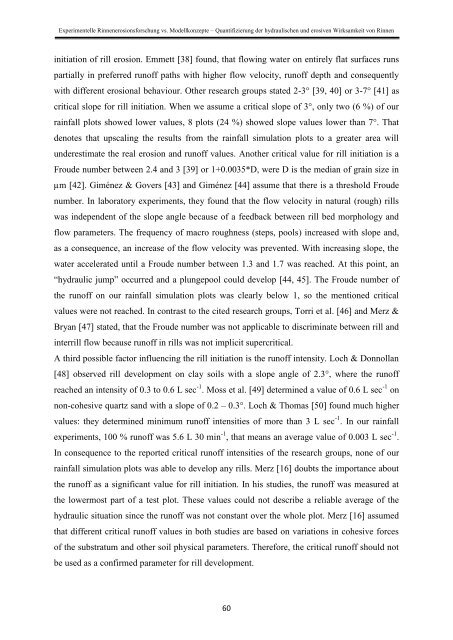Stefan Wirtz Vom Fachbereich VI (Geographie/Geowissenschaften ...
Stefan Wirtz Vom Fachbereich VI (Geographie/Geowissenschaften ...
Stefan Wirtz Vom Fachbereich VI (Geographie/Geowissenschaften ...
You also want an ePaper? Increase the reach of your titles
YUMPU automatically turns print PDFs into web optimized ePapers that Google loves.
Experimentelle Rinnenerosionsforschung vs. Modellkonzepte – Quantifizierung der hydraulischen und erosiven Wirksamkeit von Rinnen<br />
initiation of rill erosion. Emmett [38] found, that flowing water on entirely flat surfaces runs<br />
partially in preferred runoff paths with higher flow velocity, runoff depth and consequently<br />
with different erosional behaviour. Other research groups stated 2-3° [39, 40] or 3-7° [41] as<br />
critical slope for rill initiation. When we assume a critical slope of 3°, only two (6 %) of our<br />
rainfall plots showed lower values, 8 plots (24 %) showed slope values lower than 7°. That<br />
denotes that upscaling the results from the rainfall simulation plots to a greater area will<br />
underestimate the real erosion and runoff values. Another critical value for rill initiation is a<br />
Froude number between 2.4 and 3 [39] or 1+0.0035*D, were D is the median of grain size in<br />
µm [42]. Giménez & Govers [43] and Giménez [44] assume that there is a threshold Froude<br />
number. In laboratory experiments, they found that the flow velocity in natural (rough) rills<br />
was independent of the slope angle because of a feedback between rill bed morphology and<br />
flow parameters. The frequency of macro roughness (steps, pools) increased with slope and,<br />
as a consequence, an increase of the flow velocity was prevented. With increasing slope, the<br />
water accelerated until a Froude number between 1.3 and 1.7 was reached. At this point, an<br />
“hydraulic jump” occurred and a plungepool could develop [44, 45]. The Froude number of<br />
the runoff on our rainfall simulation plots was clearly below 1, so the mentioned critical<br />
values were not reached. In contrast to the cited research groups, Torri et al. [46] and Merz &<br />
Bryan [47] stated, that the Froude number was not applicable to discriminate between rill and<br />
interrill flow because runoff in rills was not implicit supercritical.<br />
A third possible factor influencing the rill initiation is the runoff intensity. Loch & Donnollan<br />
[48] observed rill development on clay soils with a slope angle of 2.3°, where the runoff<br />
reached an intensity of 0.3 to 0.6 L sec -1 . Moss et al. [49] determined a value of 0.6 L sec -1 on<br />
non-cohesive quartz sand with a slope of 0.2 – 0.3°. Loch & Thomas [50] found much higher<br />
values: they determined minimum runoff intensities of more than 3 L sec -1 . In our rainfall<br />
experiments, 100 % runoff was 5.6 L 30 min -1 , that means an average value of 0.003 L sec -1 .<br />
In consequence to the reported critical runoff intensities of the research groups, none of our<br />
rainfall simulation plots was able to develop any rills. Merz [16] doubts the importance about<br />
the runoff as a significant value for rill initiation. In his studies, the runoff was measured at<br />
the lowermost part of a test plot. These values could not describe a reliable average of the<br />
hydraulic situation since the runoff was not constant over the whole plot. Merz [16] assumed<br />
that different critical runoff values in both studies are based on variations in cohesive forces<br />
of the substratum and other soil physical parameters. Therefore, the critical runoff should not<br />
be used as a confirmed parameter for rill development.<br />
60
















